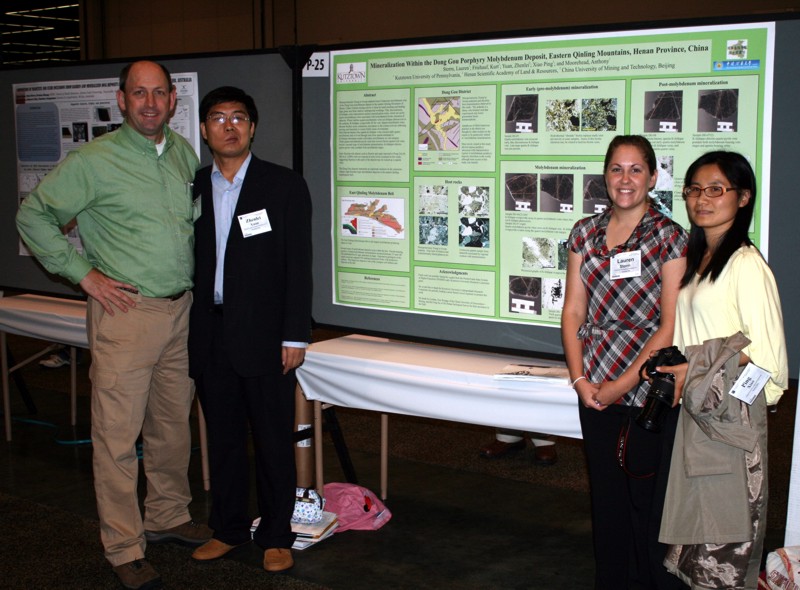
 Mineralization
within the Dong Gou porphyry molybdenum deposit, Eastern Qinling
Mountains, Henan, China
Mineralization
within the Dong Gou porphyry molybdenum deposit, Eastern Qinling
Mountains, Henan, China
Storm,
Lauren, Friehauf,
Kurt, Yuan, Zhenlei, Xiao, Ping, and Moorehead,
Anthony, 2009, Mineralization
within
the
Dong
Gou
porphyry molybdenum deposit, Eastern Qinling Mountains, Henan,
China [abs]: 2009 Portland GSA Annual Meeting (18-21 October
2009), Geological Society of America Abstracts with Programs, Vol.
41, No. 7, p. 84.
 Mesoproterozoic Xiong’er Group
andesite hosts Cretaceous molybdenum ores in the Dong Gou molybdenum
deposit in the eastern Qinling Mountains of Henan, China. Current
mining activity is done by hand mucking and hauling high grade ores
from shallow underground workings. Thin, discontinuous K-feldspar
veins characterize earliest mineralization styles, which are cut by
quartz-molybdenum veins associated with hydrothermal biotite
alteration of andesite. Where hairline quartz-molybdenite veins cut
feldspar phenocrysts in the andesite, K-feldspar overgrowths fill
the vein. Quartz-molybdenite veins became thicker, more continuous,
and planar as the system evolved, reflecting cooling and transition
to a more brittle strain environment. Molybdenite-barren, blue
apatite-K-feldspar veins crosscut early quartz-molybdenite and
evolved through time from apatite-dominant to K-feldspar-dominant
modes with minor molybdenum on vein margins. Thick
quartz-molybdenite-pyrite veins that crosscut barren apatite-rich
veins record a second stage of molybdenite mineralization.
K-feldspar-chlorite-quartz-pyrite veins postdate both molybdenite
stages.
Mesoproterozoic Xiong’er Group
andesite hosts Cretaceous molybdenum ores in the Dong Gou molybdenum
deposit in the eastern Qinling Mountains of Henan, China. Current
mining activity is done by hand mucking and hauling high grade ores
from shallow underground workings. Thin, discontinuous K-feldspar
veins characterize earliest mineralization styles, which are cut by
quartz-molybdenum veins associated with hydrothermal biotite
alteration of andesite. Where hairline quartz-molybdenite veins cut
feldspar phenocrysts in the andesite, K-feldspar overgrowths fill
the vein. Quartz-molybdenite veins became thicker, more continuous,
and planar as the system evolved, reflecting cooling and transition
to a more brittle strain environment. Molybdenite-barren, blue
apatite-K-feldspar veins crosscut early quartz-molybdenite and
evolved through time from apatite-dominant to K-feldspar-dominant
modes with minor molybdenum on vein margins. Thick
quartz-molybdenite-pyrite veins that crosscut barren apatite-rich
veins record a second stage of molybdenite mineralization.
K-feldspar-chlorite-quartz-pyrite veins postdate both molybdenite
stages.
Early fluorine-rich phases such as fluorite and topaz reported at
Dong Gou by Wei et al. (2009) were not exposed at mine levels
examined in this study, suggesting fluorine in this part of the
deposit may be locked up in apatite veins.
The Dong Gou deposit represents an important variation on the
extension-related, high-fluorine-type molybdenite deposits in the
eastern Qinling metallogenic belt.

 Mineralization
within the Dong Gou porphyry molybdenum deposit, Eastern Qinling
Mountains, Henan, China
Mineralization
within the Dong Gou porphyry molybdenum deposit, Eastern Qinling
Mountains, Henan, China 
 Mineralization
within the Dong Gou porphyry molybdenum deposit, Eastern Qinling
Mountains, Henan, China
Mineralization
within the Dong Gou porphyry molybdenum deposit, Eastern Qinling
Mountains, Henan, China  Mesoproterozoic Xiong’er Group
andesite hosts Cretaceous molybdenum ores in the Dong Gou molybdenum
deposit in the eastern Qinling Mountains of Henan, China. Current
mining activity is done by hand mucking and hauling high grade ores
from shallow underground workings. Thin, discontinuous K-feldspar
veins characterize earliest mineralization styles, which are cut by
quartz-molybdenum veins associated with hydrothermal biotite
alteration of andesite. Where hairline quartz-molybdenite veins cut
feldspar phenocrysts in the andesite, K-feldspar overgrowths fill
the vein. Quartz-molybdenite veins became thicker, more continuous,
and planar as the system evolved, reflecting cooling and transition
to a more brittle strain environment. Molybdenite-barren, blue
apatite-K-feldspar veins crosscut early quartz-molybdenite and
evolved through time from apatite-dominant to K-feldspar-dominant
modes with minor molybdenum on vein margins. Thick
quartz-molybdenite-pyrite veins that crosscut barren apatite-rich
veins record a second stage of molybdenite mineralization.
K-feldspar-chlorite-quartz-pyrite veins postdate both molybdenite
stages.
Mesoproterozoic Xiong’er Group
andesite hosts Cretaceous molybdenum ores in the Dong Gou molybdenum
deposit in the eastern Qinling Mountains of Henan, China. Current
mining activity is done by hand mucking and hauling high grade ores
from shallow underground workings. Thin, discontinuous K-feldspar
veins characterize earliest mineralization styles, which are cut by
quartz-molybdenum veins associated with hydrothermal biotite
alteration of andesite. Where hairline quartz-molybdenite veins cut
feldspar phenocrysts in the andesite, K-feldspar overgrowths fill
the vein. Quartz-molybdenite veins became thicker, more continuous,
and planar as the system evolved, reflecting cooling and transition
to a more brittle strain environment. Molybdenite-barren, blue
apatite-K-feldspar veins crosscut early quartz-molybdenite and
evolved through time from apatite-dominant to K-feldspar-dominant
modes with minor molybdenum on vein margins. Thick
quartz-molybdenite-pyrite veins that crosscut barren apatite-rich
veins record a second stage of molybdenite mineralization.
K-feldspar-chlorite-quartz-pyrite veins postdate both molybdenite
stages.